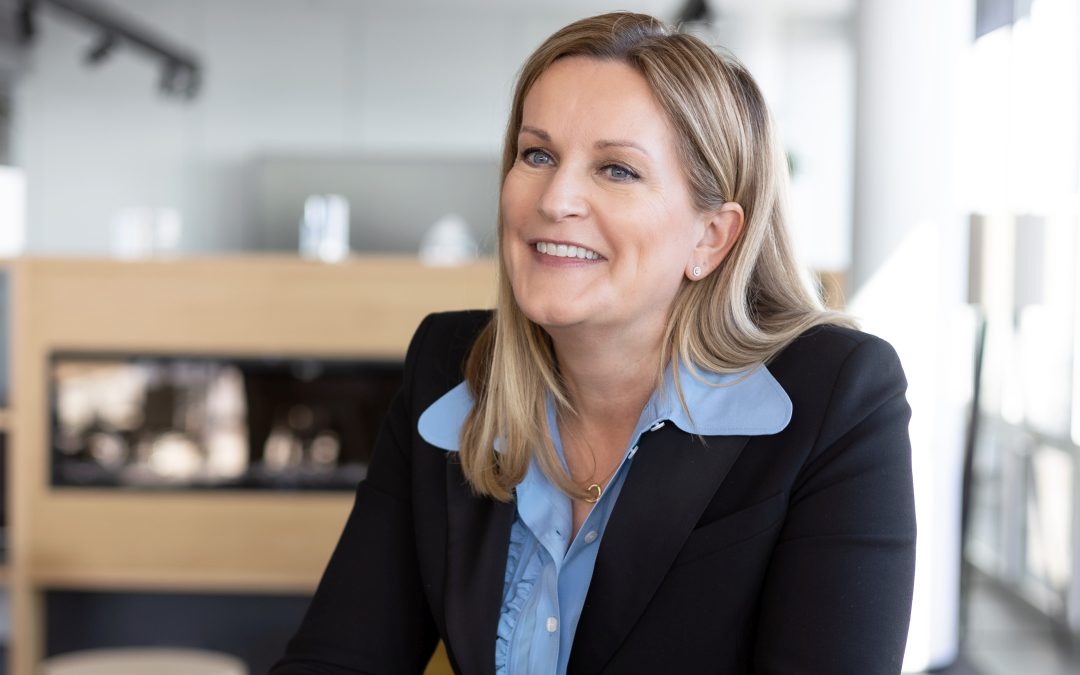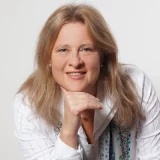We welcome our new sponsoring member, MEAG. We want to know right away what they are doing in terms of diversity and talk to Katja Lammert. She is Chief Administration Officer there and is responsible for Legal, Regulatory & Compliance, Operations, Portfolio Administration, IT, Outsourcing Controlling and ESG.
Katja, you are a lawyer by profession, so first a legal question: What can we expect from the EU social taxonomy in terms of diversity?
We can expect the EU social taxonomy to bring concrete guidelines at the political level. We expect that there will be something on the gender pay gap, and in any case there will be transparency requirements, for example regarding working conditions in care situations or during parental leave.
When will the social taxonomy come into force?
Personally, I don't think it will come before 2024. Then with reporting obligations in 2025 about the year 2024.
You joined MEAG's management team on 1 October 2021. Before that you were a self-employed lawyer specialising in the fund business. What is it like to work for such a large company?
Before I became self-employed, I was on the board of a medium-sized company. Why am I now with a large corporation? I was simply convinced by the MEAG model. There you have the potential and the internationality of a large group. At MEAG we are currently undergoing a strategic change and are pushing ahead with a comprehensive development: from a group asset manager to an asset manager that is consistently expanding its business with external institutional clients and is also active on the market. Because of this, there is a real start-up spirit here; every stone is turned over, processes are questioned, new structures are set up, new products are designed: For someone like me who likes to design, this is a very optimal environment.
What I particularly enjoy is the daily intercommunication; this is probably the biggest change from my self-employment as a lone fighter in the last two years. But since I find leadership and interaction enriching rather than exhausting, this change is easy to cope with.
I also find the breadth of the business model across all asset classes - liquid & alternative assets as well as real estate - exciting.
Is there also a flip side to the coin?
Of course, there are those too. Themes like "we've always done it that way and don't want to question it" can also be found here - as in other houses. But this is also changing with the strategic reorientation, and the spirit of optimism dominates in the house.
You are 2 women out of 9 members on MEAG's management board. That is exemplary, considering that the average in the management of German fund companies is only 13.7%. What is MEAG doing to provide a good climate for career women?
If you look at it more closely, even better: MEAG is divided into two companies; MEAG Asset Management - here we are four gentlemen and one lady - and MEAG KAG - there we are four gentlemen and two ladies. My colleague Prashant Sharma and I have dual functions and work for both companies.
(Gender) diversity is not just lip service here, but is taken seriously and a lot is done to promote women and bring them into leadership positions. This is also clearly visible: In the last year, we have really developed a lot of women in leadership positions. Of all the (internal + external) management positions filled in 2021, 35% were female. That puts us in a good position.
Diversity is of course also supported by the management level, for example the patron of our internal women's network is a man - my colleague Prashant Sharma!
What fixed diversity goals have you set for yourselves at MEAG?
As a Group, we have set firm targets to have 40% of all management positions filled by women by 2025. To ensure that diversity is taken into account when filling management positions, our selection process stipulates that a female manager is on the decision-making body to ensure that women have equal opportunities. However, care is also taken to ensure that male colleagues benefit from the change in thinking and that, for example, it is normal for them to also take parental leave.
What else do you do in terms of promoting women?
We make sure that diversity is anchored in the entire spectrum of the employee life cycle. Starting with a strong external image, we are continuously working on our employer branding and the way we approach our new candidates. This pays off in recruiting; we notice that when choosing an employer, it is no longer just tasks and salary that play a role, but also cultural and social aspects. For example, it is also important to applicants how a company positions itself with regard to ESG and whether or which social projects are supported or initiated.
In particular, we also set a target of a half distribution between male and female candidates in our trainee programme; last year we even had 56% women in the trainee programme. However, we also see that a stronger representation of female candidates in portfolio management is difficult. The profession does not seem to be as popular or perhaps not as present among female graduates and applicants.
In addition, we have, for example, removed the subjective element from our salary system in order to avoid gender-specific discrimination.
And to facilitate and promote the compatibility of family & career, we offer crèche places through a provider working exclusively for MEAG. We also like to cooperate with the internal women's network, and also use various exchange formats to increase the visibility of our female talent. Of course, we also use our mother and there are various initiatives together with Munich Re.
In order to widen the range of female managers in the financial sector, you have to start already in education - well before entering the profession - because, as you also show in the Fearless Girls study, the financial sector is unfortunately not perceived as very attractive by female students and graduates. I.e. here you have to show yourself as an employer at universities in order to introduce the financial sector to (female) students. We want and need to show that the finance industry is creative and offers an incredible variety of opportunities.
Bloomberg launched an initiative this year, of which I am an ambassador - the EU Women in Finance Initiative. This was launched in March this year and is also intended to help attract more women to the finance industry. The initiative has been rolled out across the EU and is supported by female Ambassadors - female board members/executives from large companies and/or the public sector from the different Member States. The Ambassadors have the roles of giving companies and the financial sector strong female voices and encouraging young women in particular to either choose a career in finance for the first time or to have the courage to throw their hats into the ring for a management position or another exciting challenge, even if it may be a risk at first sight.
I also try to strengthen this effect by participating in appropriate panels in order to give MEAG a strong female voice here as well.
What diversity criteria do you look for in your portfolio companies?
A combination of everything. The most obvious factor is, of course, women in leadership, which is also where the greatest need for action is; but we are looking for balance overall.
How do you proceed?
We use various ESG ratings that cover topics such as board diversity, working conditions and remuneration systems. It's difficult to ask about other topics purely through the ratings; hard facts about the pay gap, for example, can really only be obtained through engagement.
In the illiquid area, where we are very active, it is easier than in the liquid area. There, we can talk to the relevant people through direct engagement and ask them the necessary questions.
Who provides you with the necessary diversity data in the liquid sector?
Because we invest internationally, we mainly use MSCI and Bloomberg. Bloomberg also has a gender index.
As you said earlier, the financial sector doesn't have the best reputation among female university graduates. What can we as an industry do about this bad image?
As I said - our industry is much more exciting and diverse than one might think from the outside! And that's where initiatives like the one mentioned above help. From my own experience, I can report from my beginnings in the financial sector - at that time in the legal sector - that my area of responsibility was always very diverse and characterised by a high degree of proximity to the business. This is quite different from some of my university friends who went into the supposedly more exciting media industry and actually only checked licensing agreements there. With ESG and sustainable finance, another exciting area has been added, which is still in the early stages of its development and thus offers a lot of creative potential.
And that's exactly why we have to advertise at the universities or go to job fairs and send young people from the company there to report on their experiences and "whet their appetite for the industry".
How do you see it: Is a responsible job in the financial sector suitable for women, or do you have to be very robust, according to the motto "only the tough get into the garden"?
I think jobs in the financial sector are very suitable for women. The jobs are, as explained, versatile and exciting and have a lot of potential.
Yes, the industry is very male-dominated. That certainly takes some getting used to for women at the beginning and maybe you also have the situation of having to listen to one or two flippant remarks. It helps to take a step back or to objectify things when necessary. However, situations like this are not unique to the financial sector, you can encounter them anywhere and you have to learn not to take things too personally.
All in all, the financial sector is very well suited for women and there are many exciting areas - certainly more than one would think from the outside.
Before you apply to a company, you can't really look inside. What advice do you have for women on what they should look for before applying to find a good company for themselves?
I look at the website and the board of a company that interests me, and also the LinkedIn presence. What does the company show about itself? Which people comment? And what? You already get a good first impression of how a company is positioned.
Talking to women from the industry or the respective companies is often difficult for a first impression... perhaps at networking events like those organised by the Fondsfrauen. But of course you get a subjective picture - depending on the people you talk to.
Can you give examples of good websites that have caught your eye?
MEAG's, of course! Take a look at it. It's exciting, and our board is also diverse. I also like the Glaxo Smithkline site.
Thank you Katja, for the good interview, and for the practical examples!



